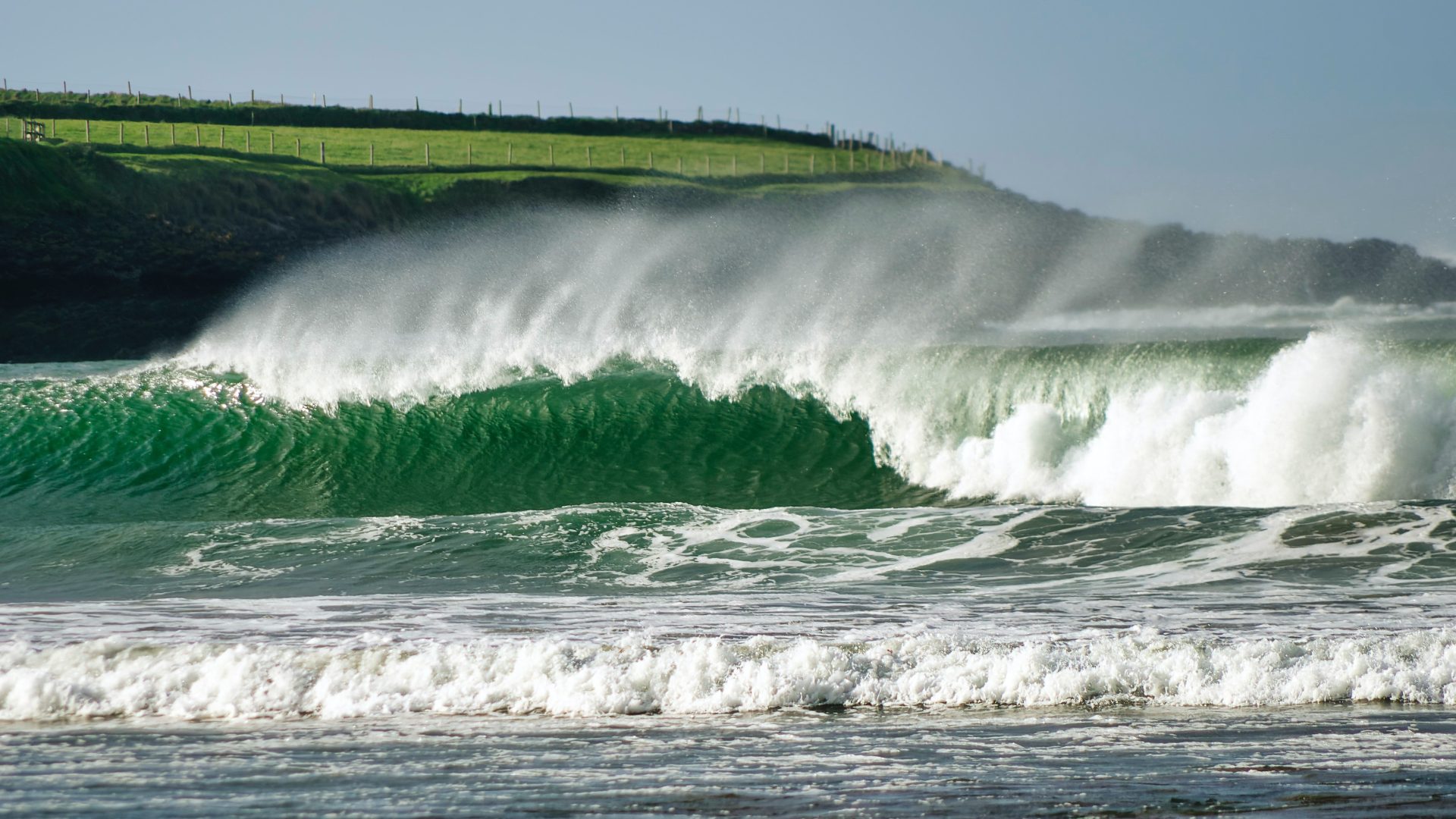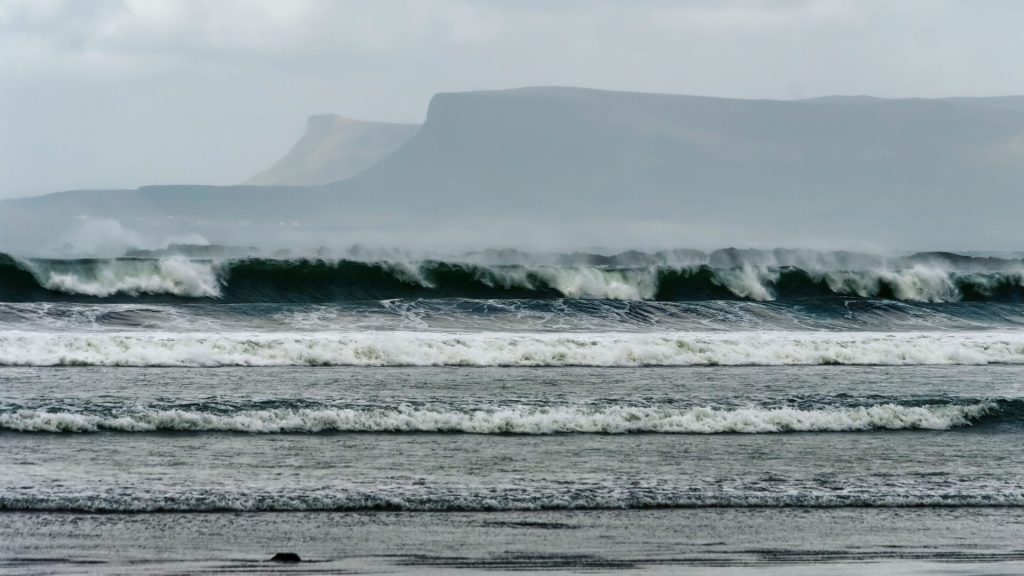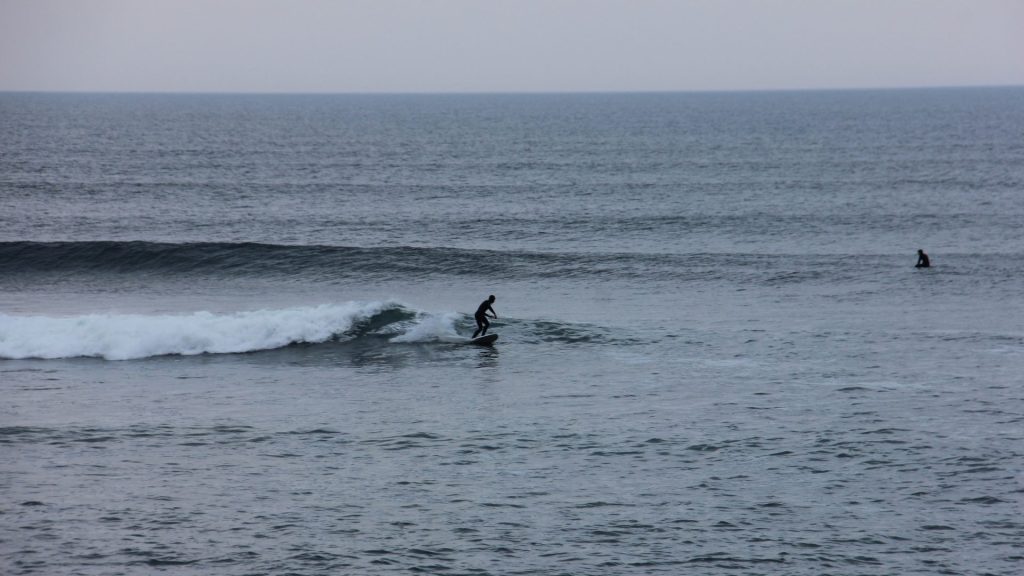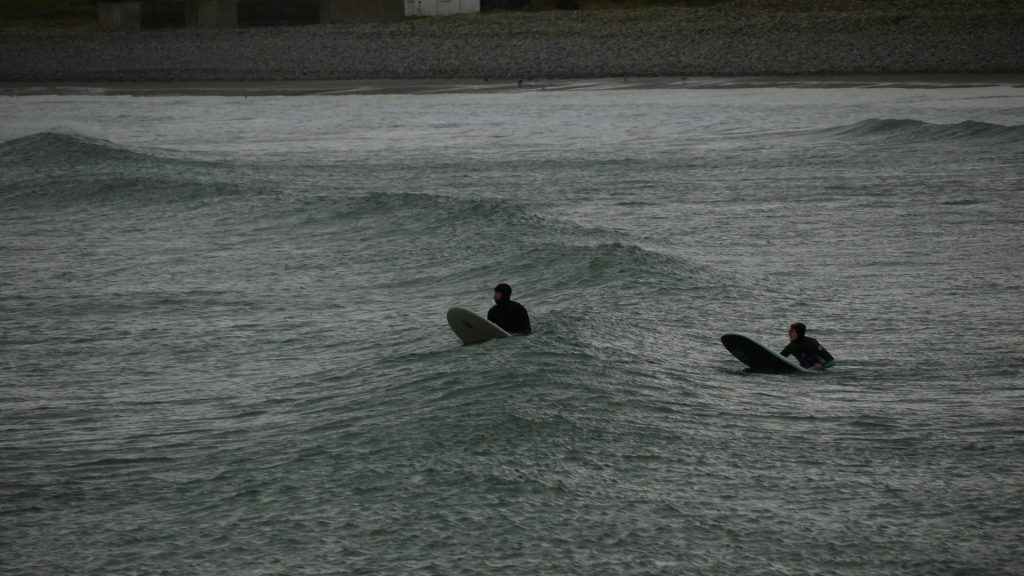Surfing in Ireland Guide 2024

So you want to know about surfing in Ireland? I don't blame you, it's an absolutely stunning country with a thriving surf culture!
This guide to surfing in Ireland will answer any questions you have about surfing or travel surrounding Ireland in 2024!
Where To Surf in Ireland
Short Answer: In Ireland you can surf at spots like Bundoran in County Donegal and Mullaghmore Head in County Sligo offering brilliant waves for surfers.
Surfing in Ireland History
From Joe Roddy's pioneering homemade board in 1949 to the establishment of the Bray Island Surf Club by Kevin Cavey in the 1960s, Ireland's surfing journey began.
The subsequent formation of the Surf Club of Ireland and the Irish Surfing Association marked key milestones, leading to the country's representation at the 1966 World Surfing Championships.
Despite internal conflicts in the late '70s and '80s, leaders like Roci Allan and Brian Britton laid the foundation for Irish Surfing's continued growth, hosting international championships and witnessing historic achievements like Ireland's 2017 third-place finish at the European Surfing Championships in Stavanger, Norway.
The sport's popularity endures with a thriving surf school industry, growing surf clubs, and ongoing national competitions.

Areas within Ireland
From the rugged Wild Atlantic Way with surf havens like Bundoran and Lahinch to the diverse options along the east coast near Dublin, Ireland's surf landscape spans scenic Northern highlights and the southern swells of Cork and Kerry.
Urban hubs such as Dublin and Galway also serve as gateways, blending city life with access to nearby coastal surf destinations.
Surfing in Ireland Quick Facts
- Ireland boasts a rugged coastline of over 3,000 miles, offering diverse and picturesque surf spots.
- Bundoran in County Donegal is often hailed as Ireland's surfing capital, drawing enthusiasts with its world-class waves.
- The Surf Club of Ireland, founded in 1962, evolved into Irish Surfing, the National Governing Body of Surfing today.
- In 2017, Ireland celebrated a historic 3rd place finish at the European Surfing Championships in Stavanger, Norway.
- With over 60 surf schools along its coast, Ireland has become a hub for surf enthusiasts and novices alike.
Best Surf Spots In Ireland
- Bundoran, County Donegal: Known as the surfing capital, Bundoran offers consistent waves at popular spots like The Peak and Tullan Strand, catering to surfers of all levels.
- Lahinch, County Clare: With its lively atmosphere, Lahinch is renowned for Aileen's, one of Europe's biggest waves, and the beach break that suits surfers of varying skill levels.
- Strandhill, County Sligo: Strandhill's diverse breaks, including the famous Strandhill Beach, attract surfers seeking challenging waves amid a scenic coastal backdrop.
- Inchydoney, County Cork: A picturesque Blue Flag beach, Inchydoney is ideal for both beginners and advanced surfers, offering consistent swells and a surf school for lessons.
- Portrush, County Antrim: Along Northern Ireland's coast, Portrush features popular breaks like Whiterocks Beach and East Strand, providing a mix of waves for surfers of different abilities.
- Rossnowlagh, County Donegal: Known for its long sandy beach, Rossnowlagh is a favourite for surfers, hosting events like the Intercounties Championships and offering ideal conditions for various skill levels.
- Portstewart Strand, County Derry: Just west of Portrush, Portstewart Strand boasts a wide sandy beach with reliable waves, attracting surfers seeking a more relaxed atmosphere.
- Brittas Bay, County Wicklow: On the east coast, Brittas Bay offers a family-friendly setting and suitable waves for beginners, making it a popular spot near Dublin.
- Tramore, County Waterford: Known for its consistent waves, Tramore is a bustling surf destination with various breaks, attracting surfers and beach goers alike.
- Achill Island, County Mayo: Offering a remote and pristine surfing experience, Achill Island's Keel Beach is known for its consistent waves and scenic surroundings, drawing surfers seeking a quieter escape.
Surfing in Ireland is full of opportunity for secret surf spots with little crowds as long as your determined to brave the climate!
The Best Spots for Beginner Surfers
Surfing in Ireland offers welcoming spots tailored for beginners. Inchydoney in County Cork stands out with its sandy shores and manageable waves, creating an ideal environment for novice surfers, especially with the assistance of a nearby surf school.
Tramore in County Waterford is another excellent choice, featuring an accessible beach and consistent, gentle waves that provide an optimal learning setting.
Meanwhile, Rossnowlagh in County Donegal boasts a long sandy beach and surf schools specifically geared toward beginners, offering a friendly introduction to the thrilling experience of catching waves for the first time.

Directions for Best Surfing in Ireland
Navigating to the best spots for surfing in Ireland involves exploring the diverse coastal regions. If heading to the west coast, where renowned destinations like Bundoran and Lahinch are located, consider taking the N15 or N17 for Bundoran in County Donegal, and the N18 for Lahinch in County Clare.
For surf adventures along the southern coast, such as Inchydoney in County Cork, take the N71 or N22. Exploring the northern coast, home to spots like Portrush in County Antrim, involves travelling along the A2 or M2.
Average Wave Height Ireland
Wave heights for surfing in Ireland vary throughout the year, influenced by the Atlantic Ocean's conditions.
During the winter months, from November to February, surfers can encounter powerful waves with heights ranging from 6 to 15 feet or even higher, attracting experienced surfers seeking challenging conditions.
In contrast, the summer months, particularly June to August, typically bring smaller waves, ranging from 2 to 6 feet, offering more suitable conditions for novice and intermediate surfers.
Best Time To Surf In Ireland
The best time for surfing in Ireland varies with the distinct seasons, each offering its own unique surf conditions.
Spring, from March to May, presents consistent swells and milder temperatures, making it an excellent season for surfers seeking a balance between wave quality and comfortable weather.
Summer, spanning June to August, features smaller waves, but the warmer weather creates an inviting environment for beginners. As autumn arrives from September to November, surfers can anticipate larger swells and a quieter atmosphere, providing an ideal setting for those seeking more challenging waves.
Winter, running from December to February, is favoured by experienced surfers as it brings powerful Atlantic swells, although the colder temperatures and stormy conditions require advanced skills and suitable equipment.
Overall, Ireland's temperate maritime climate means surfers should be prepared for changeable weather throughout the year, necessitating the use of wetsuits and appropriate gear to fully enjoy the diverse surfing experiences the country offers.
Climate When Surfing in Ireland
Ireland’s weather experiences a temperate maritime climate, characterised by mild temperatures and frequent rainfall throughout the year.
Winters, from December to February, are relatively cool with temperatures averaging between 4 to 8 degrees Celsius (39 to 46 degrees Fahrenheit). Summers, spanning June to August, are mild, with average temperatures ranging from 14 to 20 degrees Celsius (57 to 68 degrees Fahrenheit).
The country's weather is often influenced by the Atlantic Ocean, leading to frequent changes and occasional storms. Rainfall is spread evenly, but the western coasts receive more precipitation, contributing to lush landscapes.
Given the variability, it's advisable for visitors to be prepared for changing weather conditions when surfing in Ireland by carrying layers and waterproof gear.
Surfing In Ireland Need To Know
Ireland Surf Crowds
When surfing in Ireland, surf crowds vary depending on the location and time of year. Popular surf destinations like Bundoran and Lahinch can experience increased crowds during peak seasons, particularly in the summer months when both local and visiting surf enthusiasts hit the waves.
However, compared to some global surfing hotspots, Ireland's coast often offers a more relaxed and uncrowded experience, especially in less frequented areas, providing surfers with a chance to enjoy the beauty of the Atlantic waves in a serene environment.
Ireland Surf Hazards
Surfing in Ireland comes with its set of hazards, including powerful Atlantic swells that can create challenging conditions, especially during the winter months.
Cold water temperatures throughout the year require surfers to wear appropriate wetsuits and gear to prevent hypothermia.
Additionally, rocky coastlines and submerged obstacles in certain areas pose potential dangers, emphasising the importance of local knowledge and caution while navigating the diverse surf spots in Ireland.
Ireland Surf Pollution
Ireland's surf zones, while generally pristine, are not immune to the challenges of marine pollution.
Runoff from urban areas, agricultural activities, and litter can contribute to water pollution along the coastline. Surfers should be mindful of potential pollution risks, such as floating debris or contaminated water, and stay informed about local water quality conditions.
Conservation efforts and community initiatives play a crucial role in preserving Ireland's coastal environment and ensuring a cleaner and safer surfing experience for both locals and visitors.

Recommended Stays In Ireland
Surfing in Ireland can find excellent accommodations that cater to their beach side lifestyle. Coastal towns like Bundoran in County Donegal offer surf-friendly guesthouses and hostels, providing easy access to renowned surf spots.
Boutique surf lodges near Lahinch in County Clare and cosy bed-and-breakfasts in Strandhill, County Sligo, offer not only comfortable stays but also a vibrant surf culture, making them ideal bases for an unforgettable surfing experience along Ireland's scenic shores.
Ireland Surf Camps
What to Pack When Surfing in Ireland
Pack essentials like a quality wetsuit suitable for the cold Atlantic waters, booties, gloves, and a hood, especially during the winter months. Don't forget a sturdy surfboard bag, reef-safe sunscreen, a reliable leash, and appropriate layers for the ever-changing Irish weather.
When surfing in Ireland, a waterproof camera ensures you capture those memorable waves but if not don't worry! Ireland is home to many talented surf photographers.
Culture in Ireland
Immerse yourself in Irish culture by packing versatile clothing suitable for both the vibrant city life and exploring rural landscapes. A sturdy pair of walking shoes is essential for exploring historic sites and charming villages. Familiarise yourself with local customs, such as enjoying traditional music in pubs, and consider bringing a travel adaptor for your electronic devices.
Food in Ireland
While exploring Irish cuisine, savour traditional dishes like Irish stew and fish and chips, and indulge in hearty breakfasts with black and white pudding. Pack snacks for road trips or outdoor adventures and be sure to try local specialities like soda bread and artisanal cheeses. Consider dietary preferences and explore the diverse food scene, which includes fresh seafood from coastal regions.
Visa
Ensure you have the necessary visa documentation for your stay in Ireland. Many nationalities, including those from the European Union and the United States, enjoy visa-free travel for short stays. However, it's crucial to check the latest visa requirements and ensure your passport is valid for at least six months beyond your planned departure date.
Vaccines
Check with your healthcare provider to confirm routine vaccinations are up-to-date. While no specific vaccinations are required for entry into Ireland, it's advisable to stay informed about recommended vaccinations, such as Hepatitis A and B. Carry a basic first aid kit for minor injuries while exploring the outdoors.
Summing It Up: What To Do Now
Great! First of all enjoy your trip when surfing in Ireland, its such a beautiful country with great people! Secondly, double check what the waves are predicted to be like before booking to ensure it's suited to your level.
If your interested in learning more about surfing discover our many guides that will inform you on your surfing journey. Don't forget to follow us on Facebook & Instagram to stay informed on our amazing surf shots and stories shared from surf creators around the world!
Frequently Asked Questions
Does Ireland have good surfing?
Yes, Ireland has excellent surfing opportunities with world-class waves along its rugged coastline.
What is the surfing capital of Ireland?
Bundoran, located in County Donegal, is often considered the surfing capital of Ireland, renowned for its consistent waves and vibrant surf culture.
Is Dublin good for surfing?
While Dublin itself may not be a major surfing destination, nearby coastal areas such as Portmarnock and County Wicklow offer decent surf conditions for enthusiasts.
What is the best season for surfing in Ireland?
The best season for surfing in Ireland is typically during the autumn and winter months when the Atlantic swells are at their peak.
Where is the biggest surf spot in Ireland?
Mullaghmore Head, situated in County Sligo, is known for having some of the biggest surf waves in Ireland, attracting experienced surfers seeking challenging conditions.
Is Cork good for surfing?
Yes, Cork has several great surf spots, including Inchydoney and Garrettstown, making it a suitable destination for surfing along the southern coastline of Ireland.


